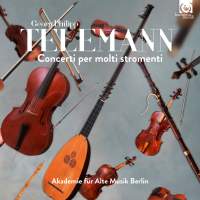Texte paru dans: / Appeared in:
Harmonia Mundi |
|
|
Outil de traduction ~ (Très approximatif) |
|
|
Reviewer: Michael
De Sapio Recordings of Telemann concertos must now number in the hundreds. But there’s always room for one more, especially when the selections are as varied and the performances as colorful as these. These concertos (and sonata) showcase Telemann’s inventiveness in scoring—geared, presumably, toward the players he had at his disposal—and variety of formal design. They vary between the Vivaldian three-movement type of concerto and Telemann’s unique four-movement type, perhaps an outgrowth of the sonata da chiesa. And they run the gamut stylistically from a Sonata a cinque in F Minor, which harkens back to the ensemble sonatas of the 17th century, to a Concerto in B Minor for Two Flutes, Calchedon (a lute-like instrument), and Strings, which definitely belongs to the galant era. The disc opens with a celebratory Concerto in D for three trumpets, two oboes, and timpani with strings and continuo. This commences with a French-overture Intrada and continues with a fugal movement which brings to mind Handel at his most festive. The B-Minor Concerto previously mentioned is a flowing, elegant four-movement work in which the calchedon plays a gentle continuo role with the solo group. The familiar Concerto in B♭ for Three Oboes, Three Violins, and Strings moves very swiftly in the Berlin group’s performance; despite speedy tempos in the outer movements, the group articulates their lines with aplomb. The opening Allegro is all witty chatter, and the finale tumbles forward. The Triple Concerto in F major from the Table Music is presented here in an arrangement with mandolin, hammered dulcimer, and harp as the solo instruments (the original was for three violins). The effect is enchanting and ethereal, and the soloists articulate their lines nicely. The Concerto in D Minor for Two Oboes and Bassoon with Strings and Continuo is a fairly somber affair, again in a four-movement design and with a fugal second movement. Another festive concerto in D closes the program, this one for three horns and violin with strings and continuo. Here the Berliners bring out the comic potential of the instrumentation, with the horn trio blasting lustily in contrast with the delicate tracery work of the violin. Annotator Peter Huth hears the influence of hunting music in this piece, and it’s hard to argue with him.
The
performances are as polished, shapely, and characterful as the works
themselves. They also breathe and are free from rushing or rhythmic
compression, the bane of too many recent Baroque recordings. The use of a
fuller string contingent in the bigger concertos (eight first and second
violins, three violas) is most welcome. The recorded sound is excellent, and
Telemann enthusiasts will certainly want to add these performances to their
collection. | |
|
Support us financially by purchasing this disc from eiher one of these suppliers. Un achat via l'un ou l'autre des fournisseurs proposés contribue à défrayer les coûts d'exploitation de ce site. |
|
|
|
|
|
Cliquez l'un ou l'autre
bouton pour découvrir bien d'autres critiques de CD |
|




